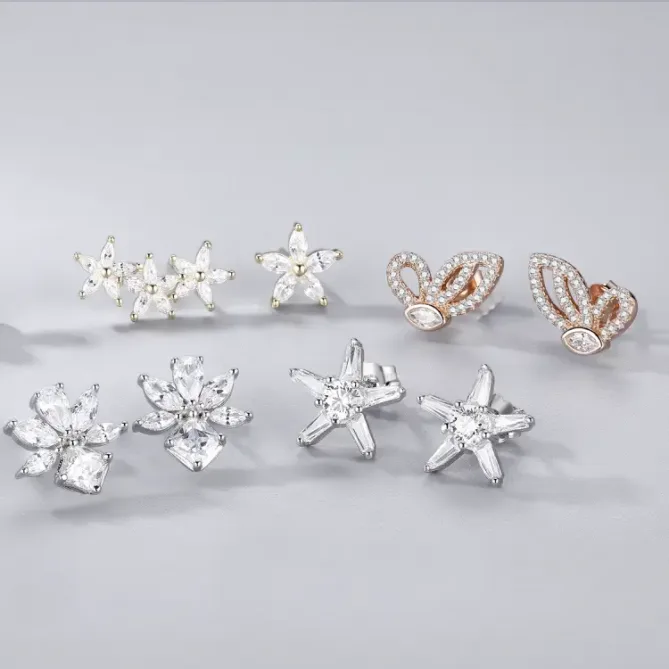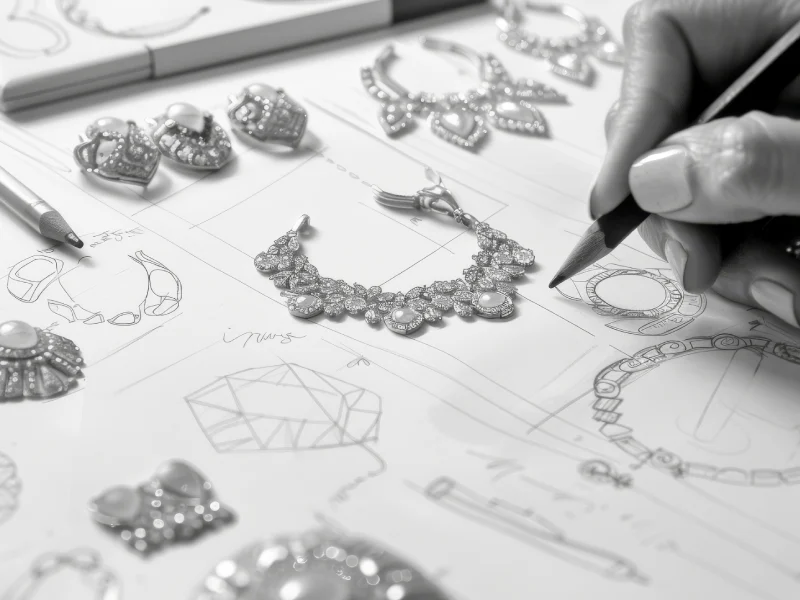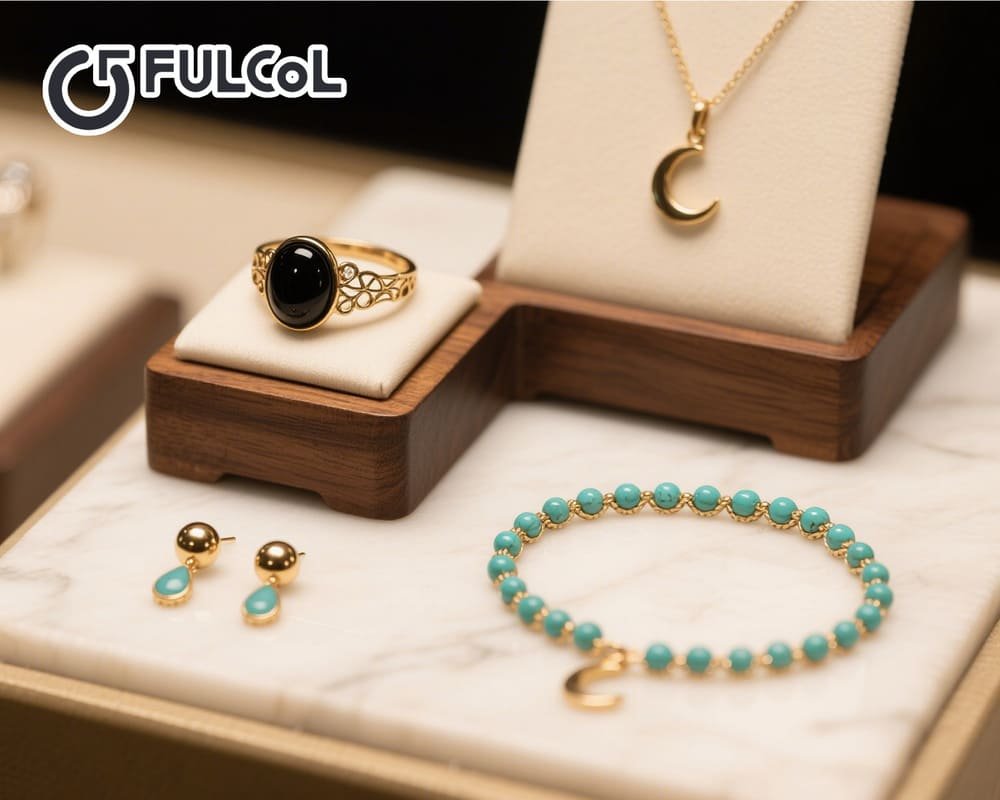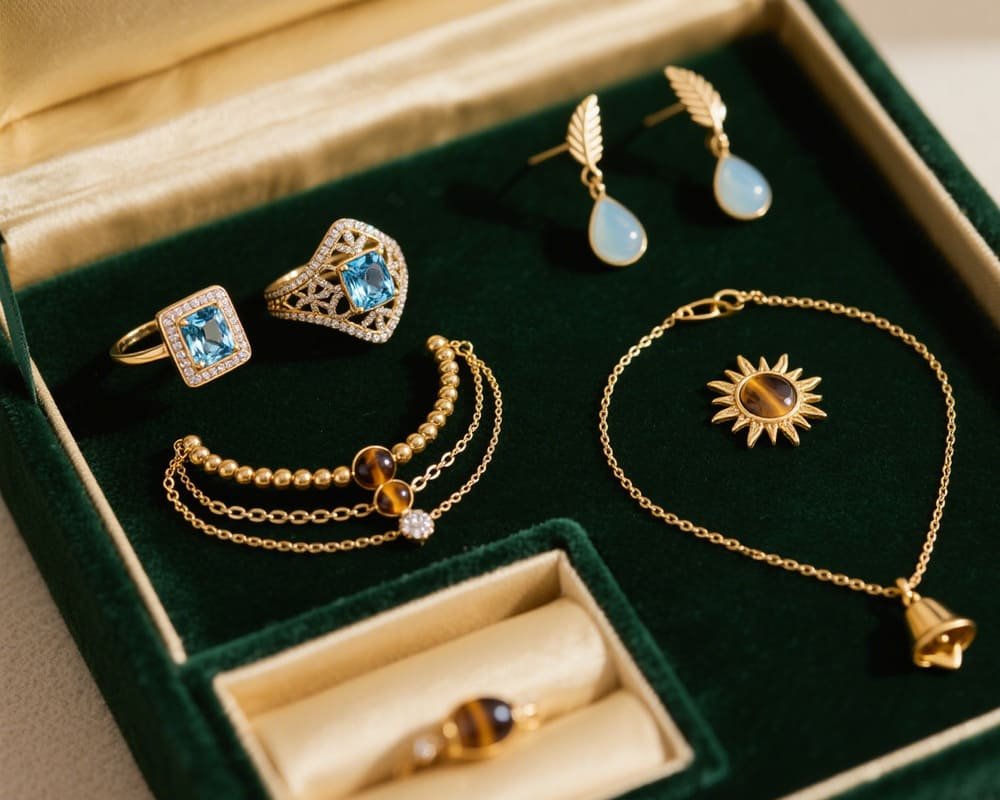When we pick up jewelry, it is often not just to decorate ourselves, but also to show a life attitude. The soft necklace gleams in the sunlight, gracefully outlining the neck. The ring between the fingers seems to be whispering, telling precious memories. Compared with expensive solid gold jewelry, gold-plated and gold-plated silver jewelry has always been popular among young people and fashionistas due to its combination of “luxury appearance + affordable price”.
But do you really understand: behind a necklace that shines through the golden luster, is it a brass base with a thin layer of gold film, or a 925 silver base with a thick gold coat? The material selection, production process, wearing experience and even daily maintenance of the two have seemingly subtle but profound differences. Fulcol, a professional wholesale jewelry manufacturers, deeply analyzes the difference between gold-plated jewelry and gold-plated silver jewelry, and provides specific purchase, maintenance, and matching suggestions to help you quickly make the best decision in the dazzling jewelry market.
Table of contents
- The basic concept of gold plated jewelry and gold vermeil jewelry
- Material comparison: base and plating
- Detailed explanation of the process
- Performance test: Which is better in terms of wear resistance and oxidation resistance?
- Maintenance and life extension tips
- Matching and style: Let every piece of “gold” tell a story
- Conclusion
The basic concept of gold plated jewelry and gold vermeil jewelry
In the jewelry industry, there are two common “gold” concepts-Gold Plated and Gold Vermeil. You know, these two are not just different in base metal, but more in their production philosophy and wearing experience.
Ordinary gold plated jewelry usually uses brass or stainless steel as the base. It first undergoes a series of surface treatments such as degreasing and pickling, and then is placed in an electrolyte. The gold ions are plated onto the metal surface through an electric current to form a gold film ranging from 0.2µm to 2µm. This process is relatively low in cost and has a variety of styles. It is undoubtedly a very cost-effective choice for friends who pursue fashion and like to change frequently.
The emergence of gold vermeil jewelry is to meet the needs of consumers who care more about skin-friendliness and durability. It uses 925 silver (or higher purity sterling silver) with a silver content of 92.5% as the carrier. It is also degreased and activated before being electroplated with a slightly thicker gold layer (usually above 0.5µm). The natural antioxidant properties of silver make it more resistant to external sweat and oxide erosion. With a thicker gold layer, the jewelry can maintain its color and texture for a longer time during daily wear.
Material comparison: base and plating
Imagine the skeleton of a piece of jewelry – it could be cheap and hard brass, or it could be the toughness of stainless steel, or the warmth of silver. Each material determines the weight, skin touch, and future maintenance methods when it is finally worn.
Ordinary gold plating on a brass base has advantages in cost and plasticity. However, if the copper ions are slightly free, it is easy to form tiny oxidation points under the gold film. You may inadvertently find that the side of the earring close to the skin has a touch of green. To avoid this “greening” phenomenon, in addition to multiple electroplating during production to increase the thickness of the gold layer, it is also necessary to strictly follow the guidelines of “stay away from sweat and chemicals” in daily use.
Although the stainless steel base is hard and corrosion-resistant, due to its dense surface, its adhesion to the gold layer is not as good as that of brass or silver. It is necessary to add an additional activation step before electroplating – such as using a special micro-etching solution to lightly polish out nano-scale holes, so that the gold film can be more firmly “hold” on the metal.
Gold vermeil on a 925 silver base is like a skin-friendly and warm “quilt”. The gold layer covers it, which has both the golden luster and the soft touch of silver. For this reason, many friends who are slightly allergic to metals tend to choose gold-plated silver styles.

Detailed explanation of the process
You may have seen the electroplating tank in the workshop, where rows of metal parts with tiny bubbles slowly rotate in the electrolyte. To make a thin layer of gold both beautiful and durable, you need to go through the following key links:
Degreasing and ultrasonic cleaning
First, the craftsman will soak the selected metal base in a strong degreasing agent and use ultrasonic vibration to completely shake off the grease and dust. Any residual oil or fingerprints will cause the subsequent gold layer to adhere unevenly, appear mottled or bubbling.
Pickling/activation
Next, the metal parts will be placed in an activation tank prepared with sulfuric acid or hydrochloric acid, and the time is precisely controlled between 30 seconds and 1 minute. This micro-etching process is equivalent to “deep cleaning” of the metal surface, while forming uniform nanopores, which increases the mechanical bite of the coating.
Electroplated gold layer
In the strictly proportioned gold salt electroplating solution, the craftsman controls the current density and temperature to allow the gold ions to be reduced and deposited uniformly at a constant speed. The electroplating time is usually between 5 and 20 minutes. The longer the time, the thicker the gold layer, but the cost and delivery time also increase accordingly.
| Process | Advantages | Disadvantages |
| Electroplating | Mature, low cost, suitable for mass production | The uniformity of the coating is affected by the current distribution |
| Vacuum plating (PVD/CVD) | High coating hardness, strong adhesion, controllable color | Large equipment investment, high unit cost |
| Chemical plating | Good uniformity, no power supply required | Higher cost, strict requirements for chemical wastewater treatment |
Post-treatment sealing layer
After the electroplating is completed, the jewelry will be rinsed with running water on the assembly line, and then dipped in a sealing liquid containing a trace amount of corrosion inhibitor to form a protective film. Some high-end factories will also spray an additional layer of nano-polymer on the outside of the gold layer to make it less likely to become dull or spotty when facing chemical corrosion such as sweat and fragrance spray.
Quality inspection and packaging
Finally, the average gold layer thickness is tested by an XRF (X-ray fluorescence) thickness gauge, and the adhesion is checked with a pull-off tester to see if it meets the industry standard. Only after meeting the standards will it be polished and dried, and then the workers will pack and ship them piece by piece.
Performance test: Which is better in terms of wear resistance and oxidation resistance?
In the laboratory, we have conducted a series of durability tests on ordinary gold-plated and gold vermeil samples of the same style:
Friction durability test: A friction meter with a pressure of 3 Newtons is used to simulate the friction during daily wear. After 5,000 round-trip frictions, about 12% of the gold layer of the ordinary gold-plated sample fell off, while only about 6% of the gold vermeil sample fell off.
Accelerated aging: The samples were placed in an atmosphere box containing 2ppm hydrogen sulfide (H₂S) for 72 hours. Ordinary gold plating slightly lost color and even had small spots; while gold-plated silver remained as golden as before.
In addition, we also tested the “skin microenvironment” that is difficult to detect with the naked eye: the subjects tested the pH and metal ion content on the skin surface after wearing for 48 hours. 10% of the subjects in the ordinary gold-plated group had slight redness and swelling. The gold-plated silver group remained in good condition and no allergic reaction was observed. It can be seen that the silver base is indeed better than the copper alloy base in terms of antioxidant and skin-friendly properties.

Maintenance and life extension tips
For any gold-plated or gold vermeil jewelry, the key to maintaining its luster and texture for a long time lies in proper maintenance and regular maintenance. Below, I will divide it into three parts from “Daily Wear Precautions”, “DIY Cleaning Operation Process” to “Professional Renovation Cycle”, with the help of specific tools, actual cases and operation steps, to present you with a maintenance guide that can be executed immediately.
Precautions for daily wear
Avoid chemical corrosion
Every time you spray perfume or makeup setting spray before going out, be sure to wait for 2-3 minutes to allow the alcohol component to evaporate completely; then put on your gold-plated jewelry. Because perfume and makeup setting spray often contain alcohol, alcohols and trace organic acids, they will produce a slight chemical reaction with the trace alloy elements in the gold layer, and over time, a mist-like oxide film that is difficult to remove will form on the surface.
Avoid high temperature and strong acids and alkalis
If you are going to the gym, it is recommended to take off all jewelry before entering the locker room and put it in a jewelry storage box with a small bag to prevent the salt in sweat and skin oil from accelerating the oxidation of the gold layer at high temperature. Similarly, whether it is using detergent for housework or chlorine in the swimming pool, it may cause the gold layer to lose its luster through reaction.
List of occasions to wear carefully
Swimming, sauna, hot spring: Never wear it. The dual effects of high temperature and chemicals will aggravate the microscopic cracks of the gold layer within tens of minutes.
Outdoor sports (running, rock climbing): It is strongly recommended to remove the jewelry. The salt and minerals in the sweat will adhere to the gaps. If not cleaned in time, it is very easy to cause black spots.
Housekeeping (washing dishes, mopping the floor): Try to wear rubber gloves before doing the operation to avoid direct contact of detergent with gold jewelry.
Professional maintenance and renovation cycle
Even with daily careful maintenance, the coating will gradually become thinner as the number of times it is worn increases. The following process is suitable for once every 6-12 months, which can effectively extend the life of the jewelry and make it look like new.
XRF coating thickness measurement
Send the jewelry to a laboratory with XRF (X-ray fluorescence) testing qualifications to test the current average thickness of the coating. Generally, when the thickness is less than 0.3μm, it is time to re-plating.
Ultrasonic deep cleaning
Use a professional ultrasonic cleaner at a frequency of 35kHz to clean microscopic dirt, and use a special jewelry cleaning solution (its pH value should be between 6-8). This step can remove impurities in the gaps that are difficult to reach with manual brushing.
Re-plating and sealing
Re-plating: Use plating bath (such as 18K gold solution) consistent with the original process, control current density and temperature, and re-plating evenly;
Sealing: Apply a layer of anti-oxidation and corrosion-inhibiting film (commercially available silane sealing agent can be used) immediately after re-plating to form a nano-level protective film on the surface of the coating to further isolate oxygen and sweat erosion.
Polishing and quality inspection
After the re-plating is completed, light polishing is performed to restore the mirror effect of the surface; finally, adhesion test and gloss measurement are performed to ensure that all indicators meet the factory standards.
Matching and style: Let every piece of “gold” tell a story
The matching of jewelry and clothing has never been a simple “color echo”, but a dialogue about texture and atmosphere. Ordinary gold plating is particularly suitable for matching with earth tones such as beige and khaki because of its warm gold color. Silver-based gold-plated silver can complement gray, black and white simple outfits because of its slightly cold base color.
If you want to stay elegant during your commute, it is recommended to wear a thin chain + a small gold-plated silver necklace, paired with a white shirt and a dark suit jacket, which is neither too ostentatious nor too textured.
When dating on weekends, you may choose an ordinary gold-plated clavicle chain with a slightly thicker gold layer, and then stack a few simple thin bracelets to create a lazy and lazy style.
If you are a party master and like to stand out, large earrings or bracelets with PVD vacuum plating (fuller metal texture) can make you instantly become the focus in the crowd.
| Start Your Custom Order | Email: info@fulcol.com | Number: +86 13055603907 |
Conclusion
When we gently put the jewelry in the palm of our hands and feel its cool and delicate touch, we are actually meeting a story – perhaps to celebrate an important moment for ourselves, or to receive a heartwarming gift from a close friend. Ordinary gold plating and gold-plated silver are not just two different craft choices, but also an extension of two life attitudes:
Ordinary gold plating, with its light cost and rich styles, allows us to dare to try and change. Imagine that in a weekend cafe, you wear a shiny gold-plated clavicle chain, pick up a book casually, and the golden light on your fingertips trembles slightly, as if announcing to the world: I love every surprise in life.
Gold vermeil has more calmness and depth. It is wrapped in a thicker layer of gold in the warm embrace of 925 silver, as if it is a persistent protection of quality. Whether it is a busy weekday morning or a tipsy party in the city night, when you wear that classic gold-plated silver necklace, it can remain consistent over the years, not fade due to frequent wear, and carry your stories and memories in the details.
Let jewelry not only be a decoration, but also a partner in your life. When you touch it in front of the mirror every day, it is a sense of ritual-reminding yourself that no matter how the outside world changes, you must keep your brilliance and confidence like this layer of gold. Every meticulous daily cleaning and every professional deep maintenance are respect for it and love for yourself.






